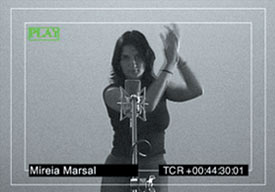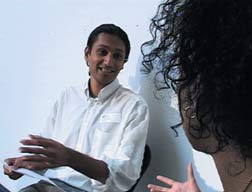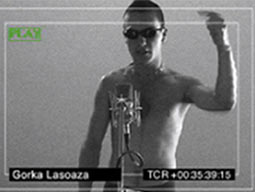 |
 |
 |
 |
 |
 |
 |
 |
 |
 |
 |
 |
 |
 |
 |
 |
 |
 |
 |
 |
 |
 |
 |
 |
 |
 |
 |
 |
 |
 |
 |
 |
 |
 |
 |
 |
 |
 |
 |
 |
Barcelona, like many other cities in Europe, is currently undergoing
demographic changes brought about Spain’s entry into the European
community, dropping birthrates among Spaniards, and rapidly accelerating
immigration from Africa, Latin America and Eastern Europe. But this increasingly
heterogeneous metropolis is also the capital of a regional government that
represents the institutionalization of Catalan identity. The transformation
of a long oppressed nationalist movement into the reigning political apparatus
of the state has led to the revindication of bilingualism and the establishment
of Catalan schools. Regional government officials must demonstrate Catalan
proficiency and state television and threatre actors in Catalunya must perform
exclusively in flawless Catalan. What is extremely difficult to discern
is the difference between a historically rooted defense of Catalan identity
against encroachment by Spanish State and burgeoning Catalanist protectionism
in the face of the hybridizing forces of globalization. In the skirmishes
over Catalan symbolic expressions resonate anxieties about whether a formerly
embattled identity can or should be extended to all the inhabitants of the
region regardless of their birthplace. |
During the same period, the wife of Jordi Pujol, the president of
Catalunya’s regional government, made xenophobicpublic statements
about how immigrant children’s speaking languages other than Catalan
was imperiling national culture. |
 |
 |
 |
 |
 |
 |
In the spring of 2001, I placed advertisements in several newspapers
in Barcelona asking for actors and actresses who could sing traditional
Catalan and who would be interested in performing in an American film. I
was looking for people who considered themselves Catalan and who would be
willing to display that sense of identity before a camera. Over seventy
people responded to the advertisements, from which I chose to work with
about twenty-five. On the set, those who needed help were assisted by a
Cuban immigrant actress who played the role of a diction corrector, a language
coach that is regularly on hand for rehearsals of Catalan thratre and television
productions to insure the “purity” of the Catalan presented
with governmental support. |
 |
 |
 |
 |
I had told the actors that if they wanted help during the recording
session, they would be taught to sing Els Segadors, a traditional hymn that
became the national anthem of Catalunya. Some of those showed up were prepared
to sing a variety of traditional songs, while others only chose to sing
the anthem. |
 |
 |
 |
 |
 |
In 2001, in the midst of mounting anxieties about the impact of immigration
on Catalan social integrity, a debate began in the Spanish press about whether
the national hymn of Catalunya, Els Segadors should be taught in the region’s
public schools. |
 |
 |
 |
 |
This video will premier at the Boijmans Museum in Rotterdam in December
2001 as part of the Unpacking Europe exhibition sponsored by Rotterdam European
Cultural. |
 |
 |
 |
 |
 |
 |
 |
 |
 |
 |
 |
 |
 |
 |
 |
 |
 |
 |
 |
 |
 |
 |
 |
 |
 |
 |
 |
 |
 |
 |
|









